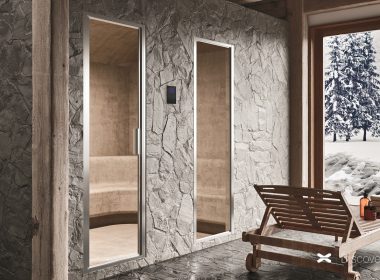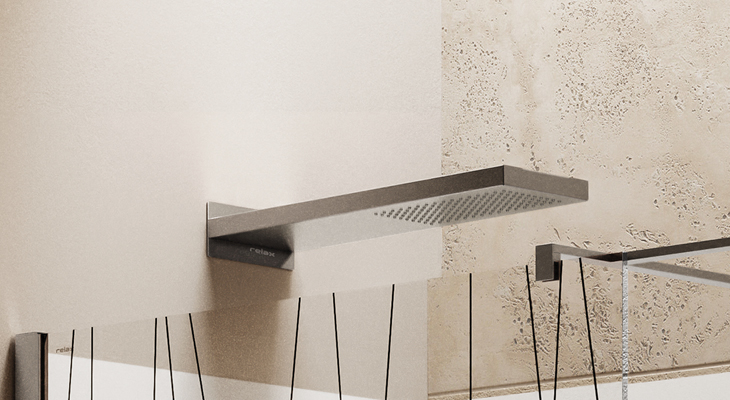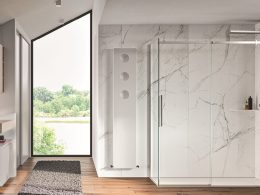In contemporary design language, even a simple shower head can become a device capable of defining the style of a bathroom. It is no longer just a technical element, but a point of visual balance that interacts with the architecture, materials and proportions of the space. The Relax, Joy and Byblos models reinterpret this role with two distinct formal approaches, offering design tools that influence the perception of the environment.
The evolution of the shower head as a design element
The development of the bathroom in recent decades has led to greater attention to the formal quality of every detail. The shower head in the bathroom is no longer seen as a marginal component, but as part of the system that defines the language of the space. The geometry of the shower tray, the verticality of the column and the arrangement of the coverings create a context in which the shower head acts as the finishing touch to the composition. When well designed, such a small object can introduce rhythm, break up linearity or reinforce a grid. The jet also contributes to the aesthetic narrative: a uniform flow suggests order and precision, while a wider, more textured flow evokes a more direct relationship with water. In this scenario, Joy and Byblos do not simply complete the shower: they orient it, generating new possibilities for interpretation.
Joy, subtraction that becomes language
The Joy collection (Joy S and Joy SC) is based on a principle of subtraction: reducing the mark until only apparent simplicity emerges. The calibrated surfaces and proportions create an object that does not impose itself, but precisely defines the horizon of the shower. Joy is a shower head that speaks through absence: no excess, no desire to be the centre of attention, just the desire to let the space express itself. It is the ideal choice when working on bathrooms with essential colour palettes, natural materials or clean architecture. The linear and orderly jet creates a feeling of continuity that dialogues perfectly with minimalist design. In the SC version, the waterfall flow introduces a more material component to the water: undoubtedly a matter of comfort, but also a way of enhancing the verticality of the shower, transforming the fall of the water into a visual gesture.
Joy S shower head
Byblos, the shower head as an architectural feature
Byblos (Byblos S and Byblos SC) belongs to another formal grammar: here it does not subtract, it constructs. Its more decisive geometry, visual weight and more evident presence make it a true architectural element. Byblos introduces a pause in the space, a sort of suspended element that reinforces the visual structure of the bathroom. It is a shower head designed for those who want to declare a precise design intention, perhaps in dialogue with material coverings, sculptural volumes or luminous scenography. The regular jet of the S version accompanies this presence. In the SC version, the waterfall becomes a blade of water that emphasises verticality and makes the shower almost a scenic device. Byblos is not an accessory: it is a formal intervention that reorganises the way the shower enclosure is perceived.
Byblos S shower head
Joy and Byblos compared: two approaches to design
Comparing Joy and Byblos means observing two opposite ways of interpreting design. Joy works on subtraction, suspension and visual lightness. Byblos works on the sign, presence and volume. In a bathroom with clean lines, Joy enters on tiptoe, keeping the perception of space open and contributing to a rigorous aesthetic. In a more material, contemporary or even slightly industrial environment, Byblos introduces a focal point, a counterbalance that gives depth to the composition. The choice, therefore, depends not only on the style of the bathroom, but on the design intention that guides it.
The shower head as a tool for defining the identity of a space
In an environment that is increasingly refined from an architectural point of view, the shower head becomes a marker of identity. It is not just a question of user experience, but of the effect that its presence has on the composition. The shower is a vertical volume that crosses the bathroom: the shower head is its upper limit, the element that defines its character. In a refined design, every detail contributes to the coherence of the visual language. Joy and Byblos respond to this need with two complementary personalities: one defines the space through lightness, the other through structure. The choice of bathroom shower head is no longer a functional gesture, but a design decision that contributes to defining the overall identity of the bathroom.
Conclusion
Joy and Byblos demonstrate how the shower head can become a true design element: not a secondary detail, but a device capable of influencing the identity of the space. Two different formal grammars that offer designers the possibility of orienting the perception of the bathroom according to two complementary visions.











